The Bottom Line
Introduction, Specifications, and Pricing
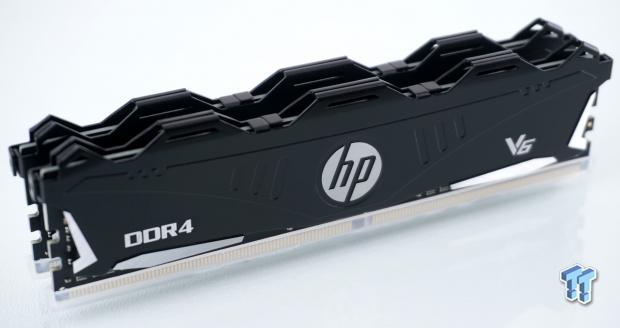
From a company with a considerable presence in the realm of personal computing, we were asked to look at something that we did not know existed. Out of the blue, we got an email, which came from HP, with an offer of DDR4 to review. After a little bit of searching, we saw, that indeed, HP is making their way into the aftermarket realm of products these days, and decided to enter the RAM segment. This decision could not have been an easy one, to have your product put into the limelight, asking reviewers to show the masses, against the likes of the big brands who already have a foothold in this segment!
With virtually no history to fall back on, personally, with HP, we are clueless as to what to expect. To be as blunt as possible, we do not have high expectations, and we could be wrong with that assessment. Even so, we plan to put what we have through the same assault course of testing and overclocking to see how it all pans out. Maybe HP will come out swinging, blow our minds, and have us wondering where they have been all our lives!
In our hands are a pair of sticks from HP, which fall into the V6 series. From what we can tell, there is a widespread of speed options, and we have also seen them with blue or black heat spreaders! With what we can tell by looking at the product we have for you, the HP V6 is visually appealing, there are no LEDs anywhere on the sticks, and HP went beyond being generic in their offering! That all said, let's get to the finer details and see what the HP V6 DDR4 offers the mainstream and enthusiast markets.
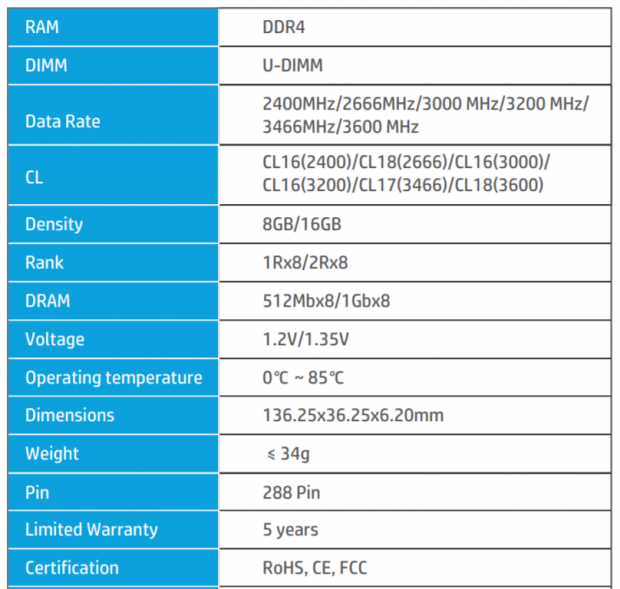
On the product page for the V6, there is a much smaller specifications chart, but if you click on the downloads tab, you will find this chart. In it, we see that the V6 is DDR4, U-DIMM, with six speeds to choose from. The 2400MHz sticks are CAS 16, the 2666MHz are CAS 18, the 3000MHz and 3200MHz sticks are CAS 16, CAS 17 is applied to the 3466MHz option, and at 3600MHz the XMP profile delivers CAS 18. We say sticks in the previous sentence, as we can find only single sticks being sold.
However, these sticks are made in 8GB or 16GB densities, and we also see the rank configurations for each. Operating voltage is 1.2V for the 2666MHx base clock of our kit, but uses 1.35V with the XMP profile activated. Interesting bits, as we conclude, are this. These sticks will work up to 85-degrees in temperature; they are 36.25mm tall, weigh in at 34 grams, and unlike most other RAM makers, we get a five-year warranty versus a lifetime warranty!
While we did see blue heat spreaders as an option, the kit we have is black. HP also makes sure to use black PCBs under the heat spreaders and to add style and definition to the heat spreaders. HP exposes the metal in various areas. The tops of the sticks are stylized when we fully expected flat plain spreaders. In all honestly, we like the aesthetics of these HP sticks; we just need to see how the performance pans out.
At this point in time, when looking for the HP V6 in retail channels, we see that "kits" are not yet a thing. On both Amazon and Newegg, we can buy single sticks, but only in 8GB of density, with no signs of the 16GB sticks. At Amazon, the most affordable price we see is $55.70 per stick. At Newegg, it is slightly more affordable, at $51.99 a stick. Comparatively, you can get G.Skill and TEAM single 8GB sticks at $33!
When building a dual-channel kit of HP, you will have to fork out over $100 at either location to do so, while you could buy TEAM, GeIL, G.Skill, OLOy, Mushkin, XPG, and even something like TridentZ sticks for less than $70! Right from the onset, we run into this hurdle, but HP can overcome this, as long as performance is top-notch!
Packaging and HP V6
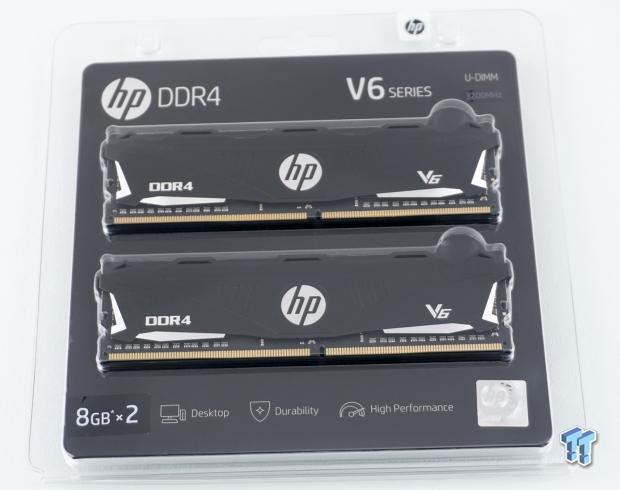
Shipped inside of clear plastic clamshell packaging with an HP tamper-proof sticker at the top, we see the V6 for the first time. Found on the cardboard insert, at the top-left is HP DDR4, and to the right is the V6 Series name, and that this is U-DIMM at 3200MHz. Taking up the majority of the packaging is the pair of sticks we will be testing. At the bottom, we see the sticker covering density, with notations following, denoting PC use, that it is durable, and that it is high-performance, and ends with a hologram HP sticker.
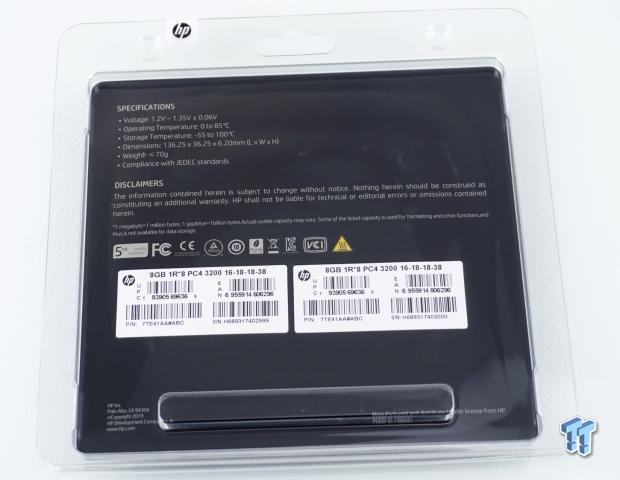
The back of that cardboard insert delivers some of the specifications we addressed earlier, but also comes with a disclaimer that information is subject to change, there is no additional warranty, and HP is not liable. As we move past that, we run into a pair of white boxes, one for each stick. The part number shown is for the kit of two and is not identical to the single sticks we see for sale.
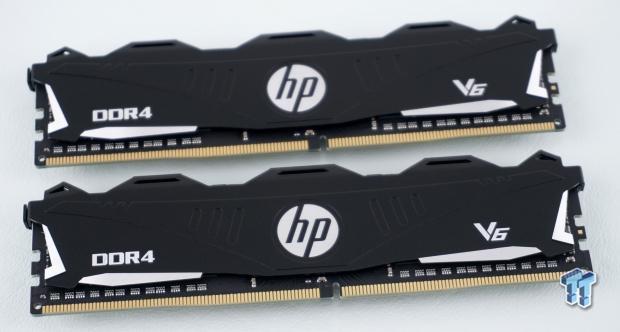
Unimpeded by plastic, we can see that HP brought style to their offering. With five teeth at the top of the spreaders, the wing design with notches and slots, even down to the exposed lined metal sections, HP delivers something attractive. While the log and the pair of shapes on either end are exposed metal, the DDR4 and V6 are painted on. We are pleased with the fact that HP did not go generic and do this on top of green PCBs!

The back of these sticks is identical to what we just saw, down to all but one detail. This side of the heat spreader does not have the exposed metal HP logo, as it is used to place the product sticker. On that sticker, we see that this is an 8GB stick of PC4 3200, with XMP timings of 16-18-18-38. Below the bar code, you will locate the serial and part numbers and the 1.35V requirement.

As both sides of the heat spreaders come together at the top, we see tabs flanking each other in the valleys, while the high points meet and nearly touch. While not particularly fantastic in their design, we appreciate that there is any style to these at all!
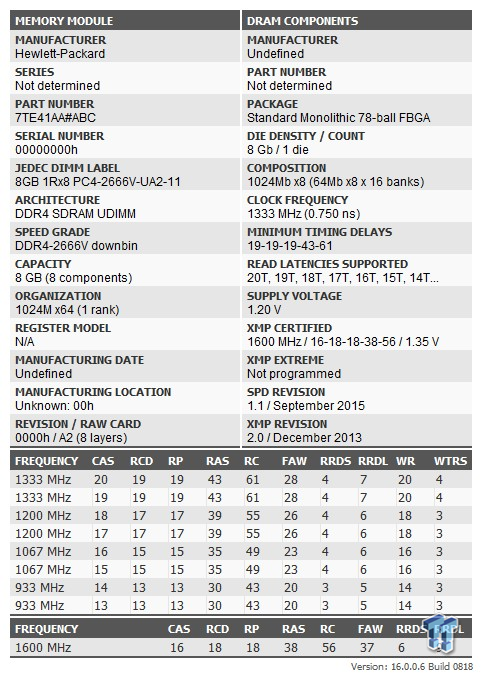
Opening Thaiphoon Burner was a massive letdown for us. HP made sure to put their name in the SPD, and the model number of the kit, but beyond that, the only thing of worth is the mention of 2666MHz as the default clock speed. Nothing as to who made the IC, which is just lazy, in our opinion.

The only way to know is to peel off the heat spreaders and look at the ICs. We find that they are all marked DT8MS075XW1, which we believe to be Micron, but are not absolute. There is nothing found looking for them online.

We get the fact that when you expose the sticker, it makes it easier on the user or technician, but in the mainstream and enthusiast market, we want to see the logo! Beyond that, we do know that they blend right into the AMD build, without being overly aggressive in the design, yet not ordinary either.

On the Intel build, we do like that the sticks are closer together, as we only have to see one sticker now. At least we do get the reflective exposed metal sections around the edges to look at.
 
Test System Details

To obtain the AMD CPU-Z screenshots, you will see directly following this image, and this is the system we used to do it, as well as in attaining the results seen in the following pages. Thanks go out to Corsair, ASUS, and GIGABYTE for supporting this venture. For detailed specifications of the system, those can be found below.
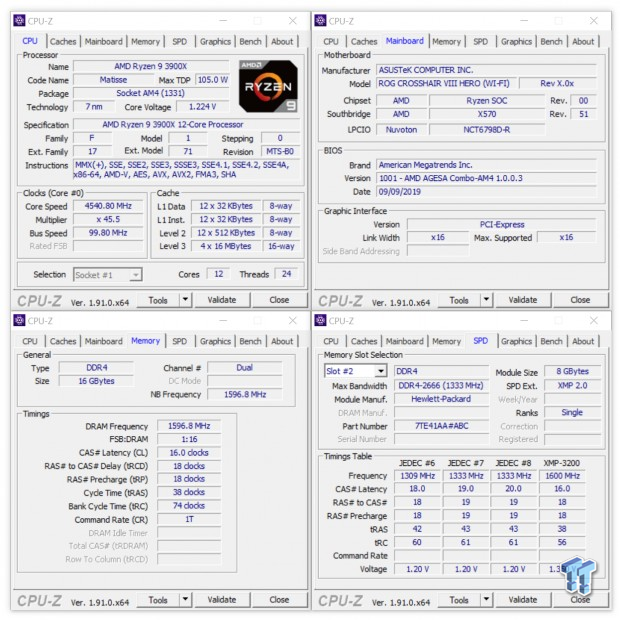
Installation went as it should, and by enabling DOCP in the BIOS, we get into windows like this. 3200MHz in speed with 16-18-18-38 1T timings, drawing 1.35V, and as to the SOC, it was set at 1.080V.

In our attempt to lower the timings, we bumped the VDIMM to 1.45V and pushed the SOC to 1.18V, to find that there is some movement when it comes to timings. CAS latency is now down to 13, but no matter what CAS timing used, we could not get the tRCD or tRP lower than 17 without issues.

We are pleased to see that we have over 300MHz to play with when attempting to increase the speed. We expected no flexibility, but getting the V6 to 3533MHz at 16-18-18-38 1T does impress us somewhat.
Chad's AMD DDR4 Dual-Channel Test System Specifications
- Motherboard: ASUS Crosshair VIII HERO Wi-Fi - Buy from Amazon
- CPU: AMD Ryzen 9 3900X - Buy from Amazon
- Cooler: Corsair H150i PRO - Buy from Amazon
- Video Card: GIGABYTE GeForce RTX 2060 SUPER Gaming OC 8GB - Buy from Amazon
- Storage: Corsair Force MP500 480GB NVMe - Buy from Amazon
- Case: Thermaltake Core P5 TG - Buy from Amazon
- Power Supply: Corsair RM750x 750-watt - Buy from Amazon
- OS: Microsoft Windows 10 Home 64-bit - Buy from Amazon
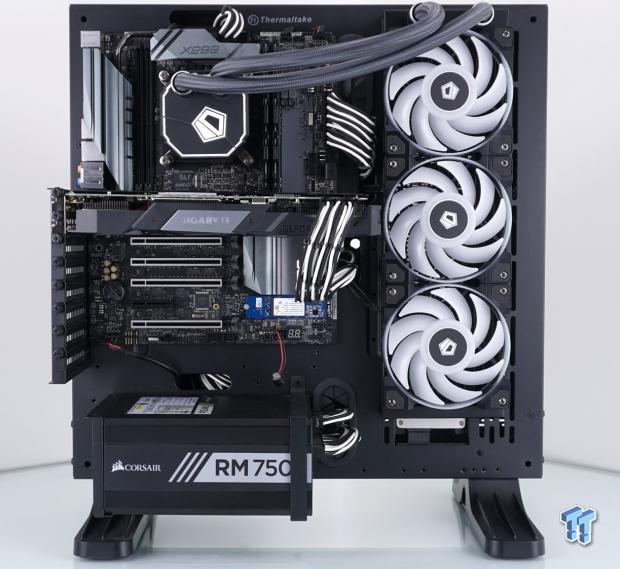
To obtain the following CPU-Z images as well as the performance seen in the charts, we are using this Intel system to do so. For this system, we were helped by Corsair, and are using the same card from GIGABYTE seen in the AMD rig. Shout outs go to them for supporting us here as well!
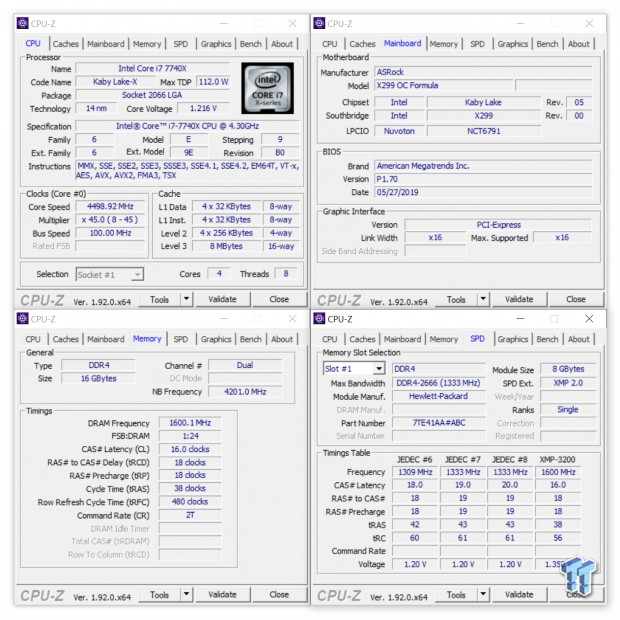
Similar to how we do it with the AMD system, this time stopping in the BIOs to enable XMP, what you see are the results. 3200MHz with 16-18-18-38 2T timings, drawing 1.35V with our VCCIO at 1.20V and the VCCSA at 1.35V.
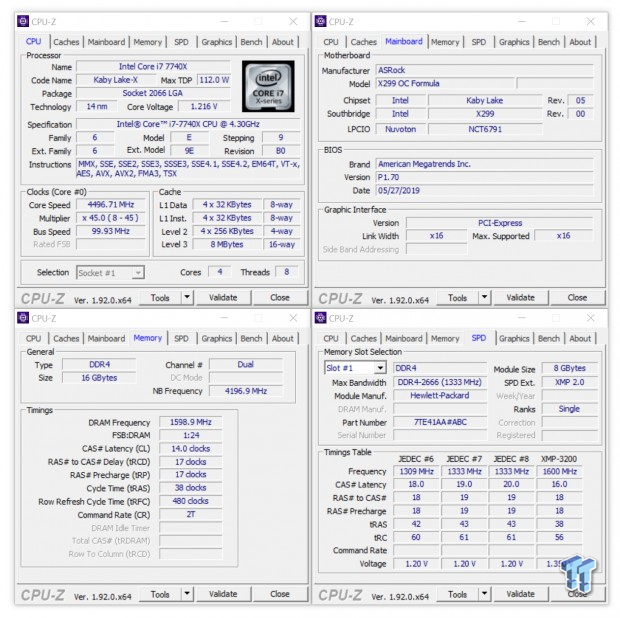
Unable to get CAS 13 on our Intel system, we got close at CAS 14! However, even here, the tRCD and tRP do not move more than one tick with 1.45V supplied to the kit. While we did adjust the VCCIO to 1.30V, we left the VCCSA at 1.35V.

The maximum speed achievable on the Intel system is less than what we saw on the AMD system, but even at 3466MHz as we have it now, we get to enjoy some overhead. Again, not the best results to date, but we never expected to see much movement of these sticks at all!
Chad's Intel DDR4 Dual-Channel Test System Specifications
- Motherboard: ASRock X299 OCF
- CPU: Intel Core i7 7740X - Buy from Amazon
- Cooler: LEPA NEOllusion - Buy from Amazon
- Video Card: ZOTAC GeForce GTX 970 AMP! Extreme Core
- Storage: Samsung XP941 256GB
- Case: Thermaltake Core P3 - Buy from Amazon
- Power Supply: Corsair RM750 - Buy from Amazon
- OS: Microsoft Windows 10 Home 64-bit - Buy from Amazon
AMD Performance
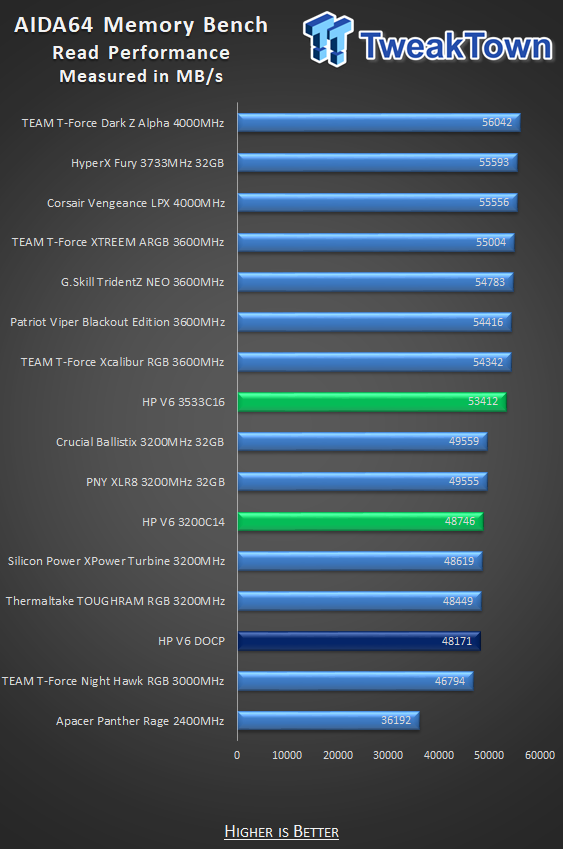
The read performance on our AMD rig is poor out of the box. Lowest of all of the 3200MHz kits by nearly 300 MB/s. Lowering the CAS to 14 put us in the mix, where the V6 should be using the DOCP profile! Adding more speed helps, and lands the V6 where it should be for 3533MHz of speed.

The write performance of the V6 is slightly better, using DOCP, and does pass at least one other kit of 3200MHz DDR4. Lowering the timings, we could not pass the PNY XLR8, but adding 366MHz of speed takes the kit into territory we expect at that speed.

Even when it comes to copy performance, we are essentially in the same boat. Not the worst of the 3200MHz kits out of the box, but nothing impressive either. Yes, overclocking shows an advantage in either setting, but lowering the timings had little effect.

Latency is a different story. There is not a 3200MHz kit in our chart with lower latency out of the box, but the results in the previous charts, once again, proves that low latency does not equal amazing things on Ryzen.
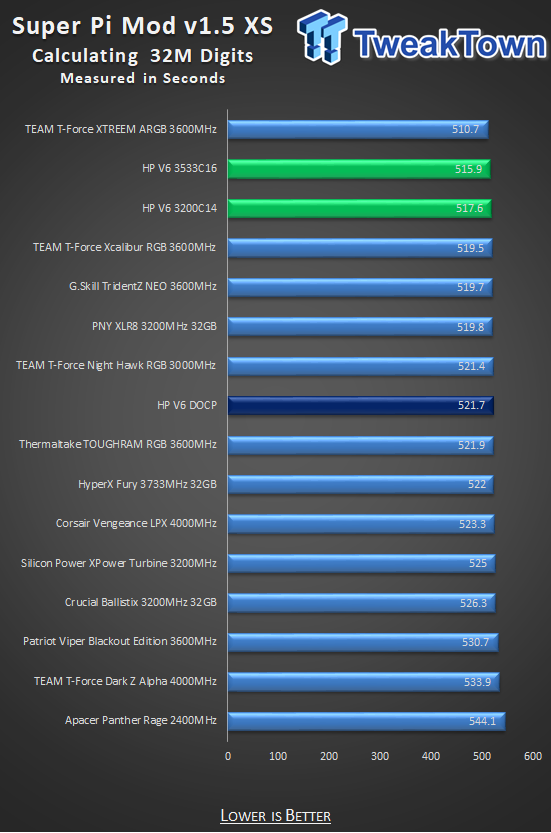
The HP V6 does like a run in Super Pi. Slightly edged out by the PNY XLR8, the V6 do pass the XPower Turbine and the Ballistix. Overclocking has a distinct advantage in this test, with nearly chart-topping performance, with higher speed edging out lowered timings.

When it came to the Physics portion of 3DMark Fire Strike, the HP V6 is at the bot5tom of the barrel for 3200MHz kits again. It took lowering the timings to pass up the XPower Turbine, and a bunch more speed to get to the PNY XLR8 performance level.

Much of the same is seen with PCMark 10 results. Out of the box, the HP V6 delivered one of the worst 3200MHz results in the chart. Overclocking was of little help to boost our spirits, and none of the results are better than any of the other 3200MHz results.

Compressing data shows that the HP V6 does surpass the XPower Turbine when using 7-zip. However, more affordable options beat it, even when overclocking the V6. We expected better results here.

Cinebench shows the V6 kit in a slightly better light, where the DOCP profile takes us beyond the PNY XLR8 score. We lowered the timings and found they can outperform the Ballistix, but the Silicon Power RAM is still beating our 3533MHz results.

For those who deal with a lot of video content, again, the HP V6 may not be for your AMD rig. By roughly four seconds, the V6 loses to the XPower Turbine, and even with both overclocked options in the chart, the PNY XLR8 and Ballistix do better, although they do have an advantage with density.
Intel Performance
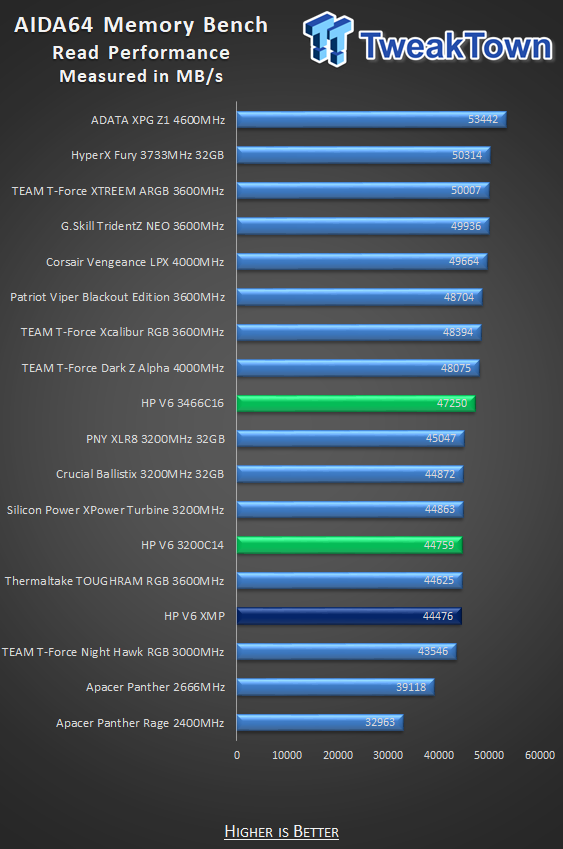
Our Intel results do not start any better if you thought it might have been the AMD rig. Read performance of the HP V6 is the lowest of any of the 3200MHz kits, nearly 400 MB/s slower. Lowering the timings did not get us to the Xpower Turbine performance; however, increasing the speed shows a considerable advantage.

Write performance in AIDA64 is more of the same. Lowest numbers out of the box for a 3200MHz kit. Reducing the timings were of little help, but at 3466MHz, there is a boost of nearly 4000 MB/s over the XMP profiles results.

Fourth from last, in AIDA64 copy performance, is where the HP V6 falls. Overclocking helps to push the V6 up the chart a bit, but at 3466MHz, we are still short of the PNY and Crucial kits.

Next to the last place in latency, there is no right way of spinning that metric in a good light! However, there are significant drops in latency when it comes to tinkering with this set of DDR4, close to what some of our highly recommended selections deliver right out of the box!

With the AMD rig, results were much better when it comes to Super Pi results. However, on this Intel system, out of the box, the V6 runs head to head with the XPower Turbine, which is excellent, but it is very odd that overclocking attempts performed worse!

We thought this was a fluke, but after multiple runs within a margin of error, we can say that the V6 does shockingly well in 3DMark Fire Strike Physics testing just by enabling XMP. Strangely, and again, retested to validate, overclocking was a detriment to scores here.

PCMark 10 hammered the V6 into submission with a third from last finish! Well beaten by any of the other 3200MHz kits in the chart, so bad, that even overclocking the HP V6 was of little help in reducing that disparity.

Repetitive at this point, but again, the HP V6 is the lowest-performing of all of the 3200MHz kits, all using the XMP profile. Overall speed was hurtful to our compression time, but with CAS 14 set, the V6 still fall almost five seconds short of the PNY kit.

Cinebench shows us that the HP V6 kit can outperform the Ballistics, but it takes the V6 with lower timings to pass the PNY XLR8 kit, and all the speed we can get from it to eek past the XPower Turbine.

Go figure, that the handbrake results would be mediocre too! Again, the bottom of the barrel for the 3200MHz kits we have tested, and at this point, even with the much better overclocking results, you can feel the tone in the air, and know how things are going to conclude.
Final Thoughts
There are a few things that we can completely appreciate from our time with the HP V6. We like the set of grapes on HP to come out to the masses and trying to break into DDR4 on the mainstream level. We appreciate the fact that we are not given naked sticks with no style, and even further, the extent that HP went to deliver an attractive aesthetic is beyond expectations. We can also appreciate the fact that ICs are sold to the highest bidder, and this late in the game, amazing ICs are not available to someone without enormous buying power. The fact that there were any test results with the V6 leading another 3200MHz set of DDR4 is a fair showing for HP. However, this is where the list stops.
On the other hand, we feel that there is too much stacked up against the HP V6. Across the twenty charts, we can almost count on one hand where the V6 shines, and over the fifty-two metrics we track for all DDR4, we can say we are not twisting the results, the V6 are not strong, in much of anything we tested! If you want to break out and have users take notice, you need the trifecta, and HP missed out of two of the three. While the V6 sticks look nice, sadly, that is where it stops. Performance is lackluster at best, across the board, and with that comes the issue with pricing!
Considering most of the comparable competition to the HP V6 will cost you only $70 or less at this point, it is a hard pill to swallow to see that to get the HP V6, we need to shell out over $100. For what? Somewhat fancy heat spreaders on black PCBs? At this point in the review, we still are not even sure of the ICs on the PCBs due to the lack of simple programming of the SPD. On that same note, this situation reminds us of the Mushkin, and SpekTek IC situation, where low-end ICs are used, and performance suffers. While we would have loved to show off something new and awesome, sadly, we just get to show you something new.
On top of that, it appears that HP is not in touch with the market or what its customers want. Sure, they work, and XMP and DOCP profiles deliver the speed and timings we expected, but with none of the performance and all of the cost. In our minds, we see no reason to buy this kit, unless you are in a brick and mortar store, with a tight timeline and no other options!
Performance | 65% |
Quality | 79% |
Features | 80% |
Value | 70% |
Overall | 74% |
They can be considered attractive looking, and DOCP and XMP profiles work without issue. Once past that, lackluster performance and inflated pricing will have potential customers looking elsewhere!
What's in Chad's PC?
- CPU: Intel Core i7 13700K
- MOTHERBOARD: ASUS ROG Maximus Z690 Hero Eva
- RAM: TEAM DDR5-7200 32GB
- GPU: ASUS GeForce RTX 3090 Eva
- SSD: addlink m.2 2TB
- OS: Windows 11 Pro
- COOLER: Fractal Lumen S36
- PSU: be quiet! Dark Power Pro 1500W
- KEYBOARD: ASUS ROG Strix Scope TKL Electro Punk
- MOUSE: ASUS ROG Strix Impact Electro Punk
- MONITOR: ASUS ROG Swift OLED PG42UQ
Similar Content
Related Tags

